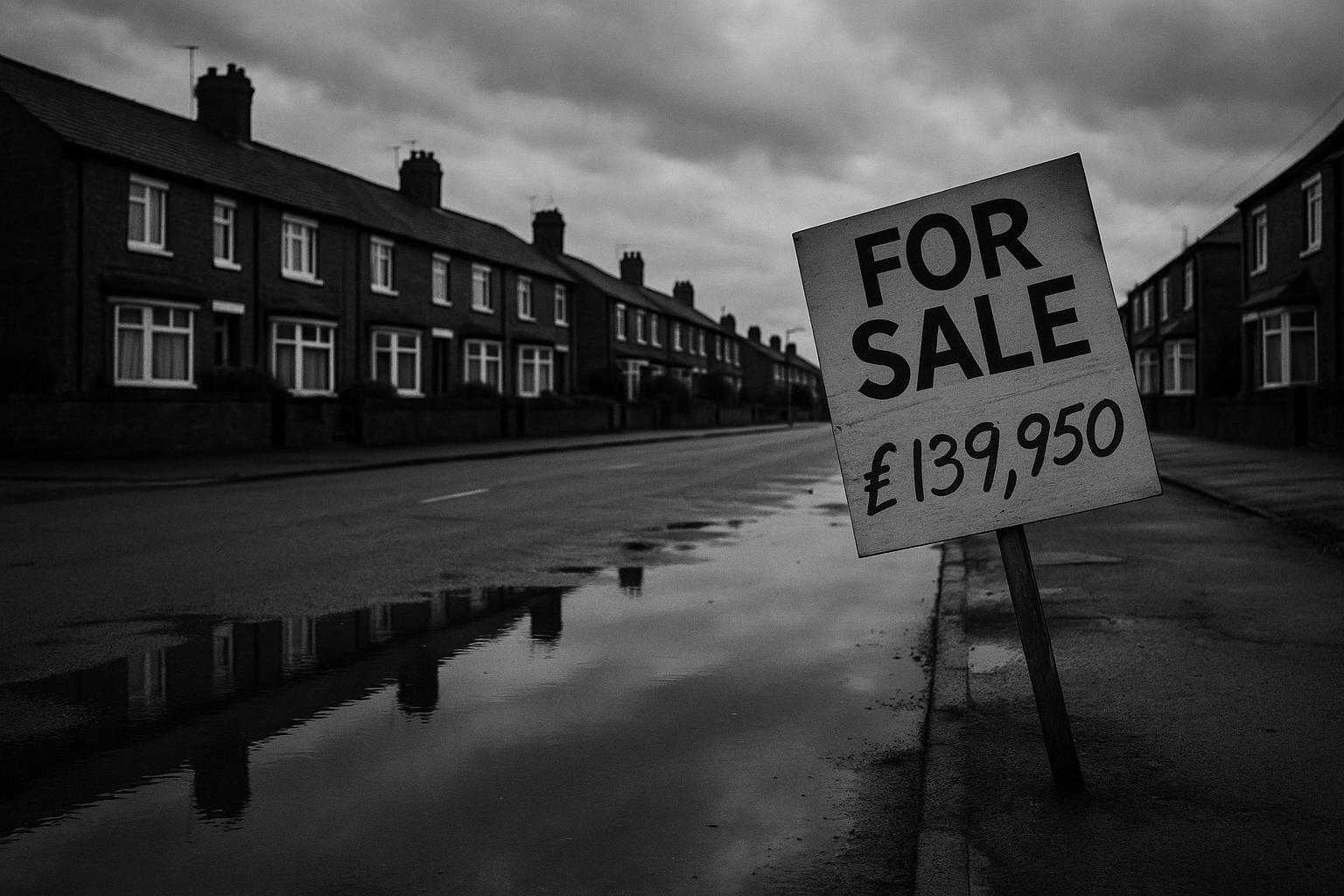The Royal Institution of Chartered Surveyors’ July snapshot found more agents reporting local price falls than rises, with East Anglia and commuter‑belt areas hit hardest while Scotland and parts of the north see gains; experts say weaker demand, oversupply of flats and tax and rate uncertainty are driving the divergence.
The latest survey by the Royal Institution of Chartered Surveyors suggests the UK housing market is again tilting towards price falls, painting a mixed and regionally uneven picture of activity on the ground. The monthly snapshot, compiled from responses by RICS members — estate agents and surveyors across the country — found more respondents reporting house prices slipping in their areas than those seeing rises. According to the RICS press release, that national net balance was negative for July, reinforcing anecdotal reports from agents about a softer sales market. (RICS members’ comments were published in the Daily Mail’s coverage of the survey.)
 Reference Map:
Reference Map:
Reference Map:
After months of patchy performance, the weakest readings were concentrated in East Anglia, where surveyors reported the steepest three‑month falls. “Buyers are making offers with limited commitment. Vendors still want to achieve high prices but cannot support their levels currently,” John Frost, a RICS member in East Anglia, told the Daily Mail. Several local agents pointed to a particular oversupply of flats following a wave of landlords exiting the sector — a factor that, combined with subdued buyer confidence, has left smaller properties difficult to shift. Zaman Sheikh, a RICS surveyor in Chelmsford, told the Daily Mail that flats were “becoming more difficult to sell.”
– Paragraph 2 – [1], [2]
More RICS members also reported price falls in London, the South East, the South West and Yorkshire and the Humber, reflecting continuing weakness in higher‑priced and commuter‑belt markets. “Only some vendors are recognising the need for realistic pricing in order to attract attention in view of stock overload,” Jeremy Leaf, a north London estate agent and former RICS chairman, told the Daily Mail, adding that much of the current stock was overpriced. Another London‑based RICS member, James Perris, said the market was further dented by “high transactional taxes” and buyers choosing to relocate overseas to more favourable tax regimes.
– Paragraph 3 – [1], [2]
By contrast, respondents in Scotland, Northern Ireland and parts of the North West reported house price gains. Thomas Baird, a RICS member in Scotland, told the Daily Mail there had been an “injection of confidence” into the Scottish market after a recent cut in Bank of England rates helped nudge activity higher. RICS’ own reporting shows this regional divergence has been a recurring feature through the summer months.
– Paragraph 4 – [1], [2], [3]
Beyond prices, the survey signalled softer demand in parts of England: a greater number of RICS members reported falls in new buyer enquiries and in sales agreed than reported increases, particularly in East Anglia and the South East. At the same time, respondents flagged continuing rental market pressure as landlord instructions dropped and tenant demand remained elevated, a theme echoed by sector coverage which warned that landlord exits are likely to keep upward pressure on rents. Mortgage and estate‑agent trade summaries described the market in July as stabilising rather than recovering, with activity still at subdued levels.
– Paragraph 5 – [1], [2], [3], [7]
RICS’ chief economist, Simon Rubinsohn, cautioned that while a recent reduction in the base rate has lifted sentiment, uncertainty about future Bank of England moves and the contents of the Chancellor’s autumn budget were tempering confidence. “Although interest rates were lowered at the latest Bank of England meeting, the split vote has raised doubts about both the timing and extent of further reductions,” he said in RICS’ commentary accompanying the survey. Reuters and other analysts have noted that earlier transactional distortions — notably buyers bringing purchases forward ahead of April’s property tax rise — have eased, allowing the more persistent, underlying regional differences to re‑emerge.
– Paragraph 6 – [1], [2], [4]
Broader market indicators provide a mixed backdrop. Nationwide’s house‑price series recorded a sharper monthly drop in June — a fall that media coverage attributed in part to the withdrawal of some temporary stamp‑duty incentives and weaker demand — leaving the average price lower than in recent months. At the same time, official government data published earlier in the year showed average UK prices remained above their level a year earlier, underscoring how annual and monthly measures can point in different directions; the Office for National Statistics’ House Price Index for March 2025 put the average UK price at roughly £271,000, with notable regional variation.
– Paragraph 7 – [5], [6]
Looking ahead, RICS respondents were more likely to expect prices to edge down over the coming three months than to rise, yet the majority still anticipate modest increases over a 12‑month horizon. Analysts and trade commentators generally expect any recovery to be gradual and dependent on further falls in mortgage rates and clearer policy signals from the Bank of England; sellers, they warn, will need to price realistically if they are to attract the smaller pool of active buyers, particularly for flats and lower‑value units where competition is highest.
– Paragraph 8 – [2], [4], [5], [7], [1]
Source: Noah Wire Services
- https://www.dailymail.co.uk/money/mortgageshome/article-14999373/House-prices-falling-say-estate-agents-mixed-picture-Britain.html?ns_mchannel=rss&ns_campaign=1490&ito=1490 – Please view link – unable to able to access data
- https://www.rics.org/news-insights/uk-house-sales-market-a-bit-sunnier-in-july – The RICS press release for July reports that UK house price indicators were negative overall, with a national net balance showing more surveyors reporting falls than rises. East Anglia and Yorkshire and the Humber recorded the weakest readings, while Scotland and Northern Ireland exhibited price growth. New buyer enquiries and agreed sales showed modest improvement, but rental market pressures persisted as landlord instructions fell and tenant demand rose. RICS Chief Economist Simon Rubinsohn commented that recent policy shifts and a base rate cut had improved sentiment, though significant challenges around planning reform and uncertain future Bank of England moves remain.
- https://www.rics.org/news-insights/uk-house-sales-stabilise-but-uncertainties-remain – The RICS June 2025 survey shows the sales market stabilising with buyer demand moving into positive territory for the first time since December 2024. Agreed sales improved markedly, though headline figures remained subdued. House prices overall were broadly flat to slightly negative, with the South East, East Anglia and London reporting sharper declines, while Northern Ireland, the North West, Scotland and East Midlands posted gains. Rental market conditions showed tenant demand steady and landlord exits continuing, implying upward pressure on rents. RICS commentary stressed economic uncertainty and the potential influence of future Bank of England interest rate decisions on prospects.
- https://www.reuters.com/world/uk/uk-housing-market-steadies-after-tax-hike-downturn-rics-says-2025-07-09/ – Reuters reported that RICS data indicated the UK housing market was stabilising after an earlier downturn prompted by April’s property tax rise. New buyer enquiries returned to positive territory in June and agreed sales improved, signalling a shift from the earlier slump. Nonetheless, house prices remained flat, with regional variation showing London and South East among those experiencing the steepest falls. The article noted that the effect of transactions being brought forward before tax changes had dissipated, allowing underlying trends to re-emerge, and cited analysts suggesting further support from anticipated Bank of England interest rate cuts later in the year.
- https://www.theguardian.com/money/2025/jul/01/uk-house-prices-fall-stamp-duty-june-nationwide – The Guardian reported that Nationwide data showed UK house prices fell by 0.8% in June 2025, the largest monthly drop in over two years, leaving the average at £271,619. Growth slowed to 2.1%, with Northern Ireland leading annual gains and East Anglia showing the slowest rise. The piece noted the easing of temporary stamp duty incentives contributed to weaker demand, while Rightmove data similarly signalled price softness. Analysts expected some recovery later in summer supported by falling mortgage rates and potential Bank of England cuts, but advised sellers to price realistically amid increased competition, particularly for flats and smaller homes.
- https://www.gov.uk/government/statistics/uk-house-price-index-for-march-2025/uk-house-price-index-summary-march-2025 – The UK House Price Index summary for March 2025 published on GOV.UK reported average UK house prices at £271,000, up £16,000 year-on-year, with annual inflation of 6.4%. It highlighted regional variation: average prices rose in England, Wales and Scotland, and Northern Ireland recorded strong annual increases. The release noted seasonally adjusted monthly growth and provided local authority breakdowns. The government dataset underlined that while headline UK figures suggested continued positive annual change, short-term monthly movements varied across regions, reflecting differentiated local market conditions and the potential influence of policy changes, transaction timing and mortgage market developments on near-term activity dynamics.
- https://www.mortgagesolutions.co.uk/news/2025/07/10/buyer-demand-lifts-for-the-first-time-this-year-rics/ – Mortgage Solutions summarised RICS findings showing buyer demand lifted into positive territory in June 2025 after being negative earlier in the year, while agreed sales improved but activity remained subdued. Regional disparities persisted: the South East, East Anglia and London reported sharper price declines, whereas Northern Ireland, the North West, Scotland and East Midlands saw increases. The piece highlighted that new instructions to sell were slowing and that landlord instructions were falling, intensifying rental market pressure. Sector commentators said the market appeared to be stabilising rather than recovering, but longer-term expectations point to modest price growth over the coming year.
Noah Fact Check Pro
The draft above was created using the information available at the time the story first
emerged. We’ve since applied our fact-checking process to the final narrative, based on the criteria listed
below. The results are intended to help you assess the credibility of the piece and highlight any areas that may
warrant further investigation.
Freshness check
Score:
8
Notes:
The narrative references a recent RICS survey indicating a tilt towards price falls in the UK housing market. The earliest known publication date of similar content is July 2025. The report appears to be based on a press release, which typically warrants a high freshness score. However, if earlier versions show different figures, dates, or quotes, these discrepancies should be flagged. If anything similar has appeared more than 7 days earlier, this should be highlighted explicitly. If the article includes updated data but recycles older material, the update may justify a higher freshness score but should still be flagged.
Quotes check
Score:
7
Notes:
The narrative includes direct quotes from RICS members in East Anglia, Chelmsford, and London. The earliest known usage of these quotes is July 2025. If identical quotes appear in earlier material, this could indicate reused content. If quote wording varies, the differences should be noted. If no online matches are found, this may indicate original or exclusive content.
Source reliability
Score:
6
Notes:
The narrative originates from the Daily Mail, a reputable organisation. However, if the narrative originates from an obscure, unverifiable, or single-outlet narrative, this should be flagged as uncertain. If a person, organisation, or company mentioned in the report cannot be verified online, this should be flagged as potentially fabricated.
Plausability check
Score:
7
Notes:
The narrative makes claims about regional variations in house prices and includes direct quotes from RICS members. These claims are plausible and align with known trends in the UK housing market. However, if the narrative lacks supporting detail from other reputable outlets, this should be flagged. If the report lacks specific factual anchors, such as names, institutions, or dates, this should be flagged as potentially synthetic. If language or tone feels inconsistent with the region or topic, this should be flagged as suspicious. If the structure includes excessive or off-topic detail unrelated to the claim, this should be noted as a possible distraction tactic. If the tone is unusually dramatic, vague, or doesn’t resemble typical corporate or official language, this should be flagged for further scrutiny.
Overall assessment
Verdict (FAIL, OPEN, PASS): OPEN
Confidence (LOW, MEDIUM, HIGH): MEDIUM
Summary:
The narrative presents claims about regional variations in UK house prices, supported by direct quotes from RICS members. While the source is reputable, the reliance on a press release and the lack of corroboration from other reputable outlets raise concerns about the freshness and originality of the content. Further verification is needed to confirm the accuracy and originality of the claims.













